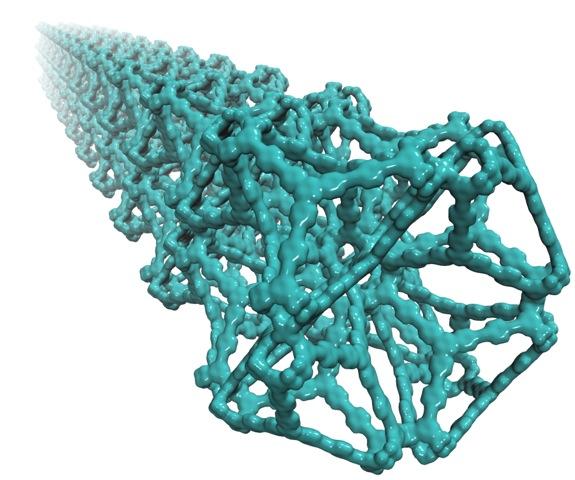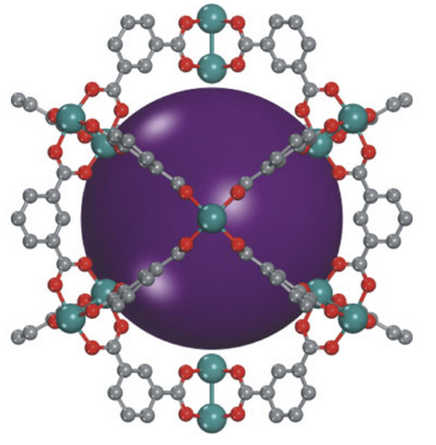A world record for highest-surface-area materials
September 13, 2012

The internal surface area of just one gram (1/28 of an oz.) of NU-110 (model shown here) would cover one-and-a-half football fields, making it ideal for natural-gas and hydrogen storage (credit: Northwestern University)
Northwestern University researchers have broken a world record by creating two new synthetic materials with the greatest amount of surface areas reported to date.
Named NU-109 and NU-110, the materials belong to a class of crystalline nanostructure known as metal-organic frameworks (MOFs) that are promising vessels for natural-gas and hydrogen storage for vehicles, and for catalysts, chemical sensing, light harvesting, drug delivery, and other uses requiring a large surface area per unit weight.
The materials’ promise lies in their vast internal surface area. If the internal surface area of one NU-110 crystal the size of a grain of salt could be unfolded, the surface area would cover a desktop.
Put another way, the internal surface area of just one gram (1/28 of an oz.) of NU-110 would cover one-and-a-half football fields.

Closeup of one NU-100 cage design (gray: carbon; red: oxygen; teal: copper; purple: size of the largest sphere that can fit with the cage (credit: Northwestern University)
The extremely high surface area was achieved using a carbon dioxide activation technique. As opposed to heating, which can remove the solvent but also damage the MOF material, the carbon dioxide-based technique removes the solvent gently and leaves the pores completely intact.
MOFs are composed of organic linkers held together by metal atoms, resulting in a molecular cage-like structure. The researchers believe they may be able to more than double the surface area of the materials by using less bulky linker units in the materials’ design.
The researchers also showed that the theoretical upper limit for MOF surface areas is 14600 m2/g (one gram of material would cover 2.7 American football fields), possibly higher.
The two MOFs display the highest experimental Brunauer-Emmett-Teller surface areas of any porous material on record, 7,000 m2/g; that is, one kilogram of the material contains an internal surface area that could cover seven square kilometers. (Brunauer-Emmett-Teller, or BET, is an analysis technique for measuring the surface area of a material.)
The MOF’s designing and synthesizing technology is being commercialized by NuMat Technologies, a Northwestern startup.
UPDATE 9/13/2012: added video and mention of storing hydrogen.